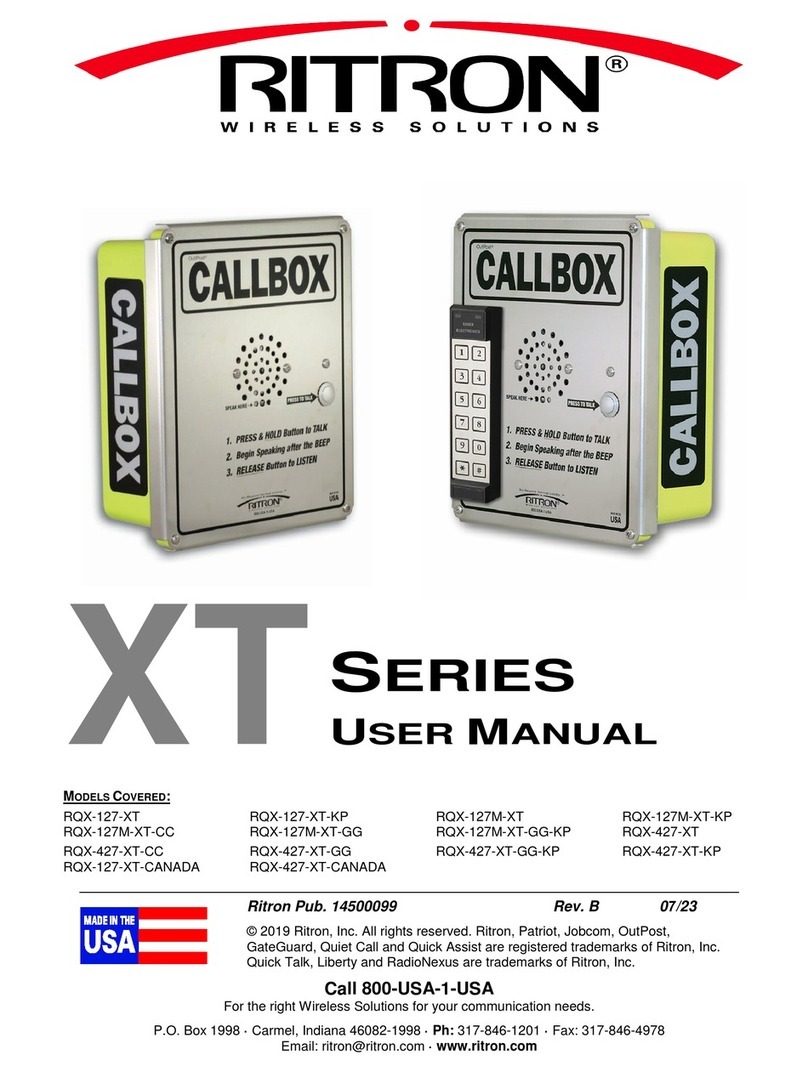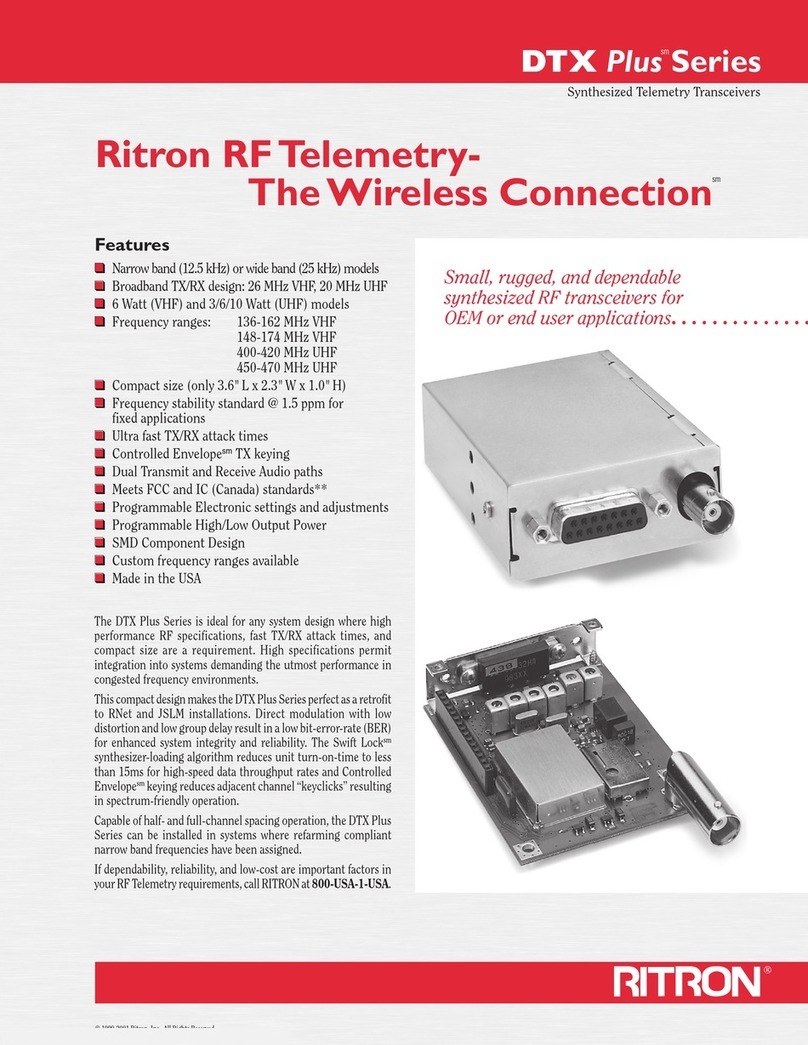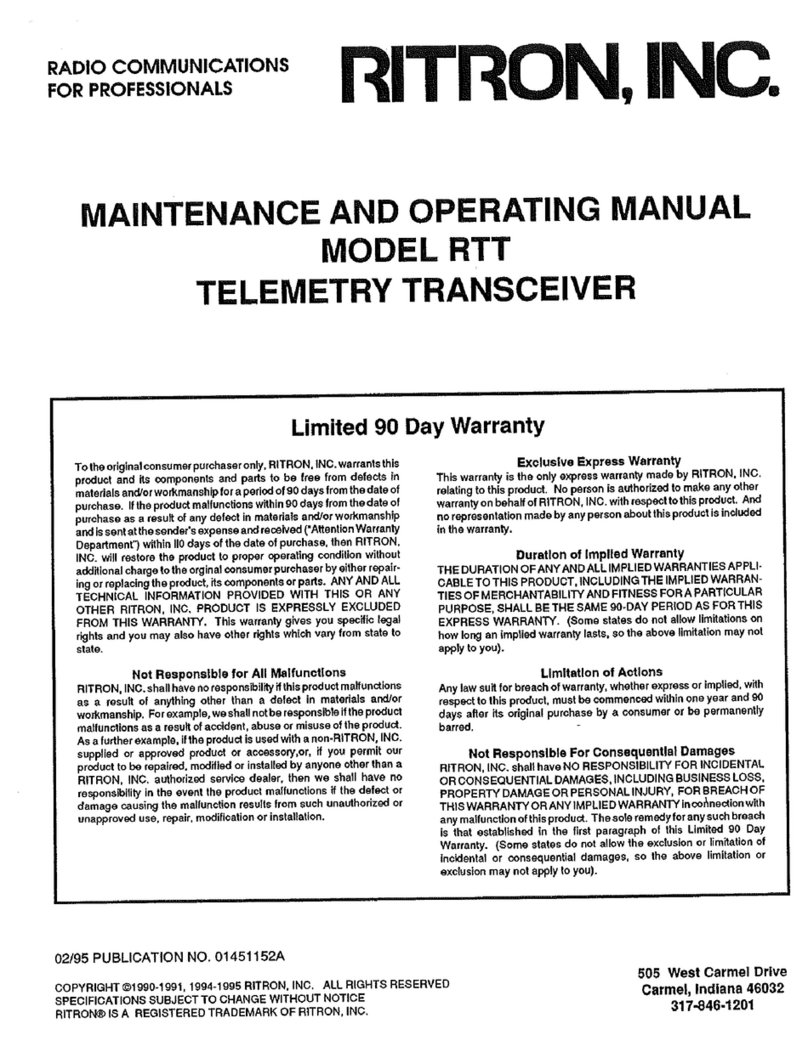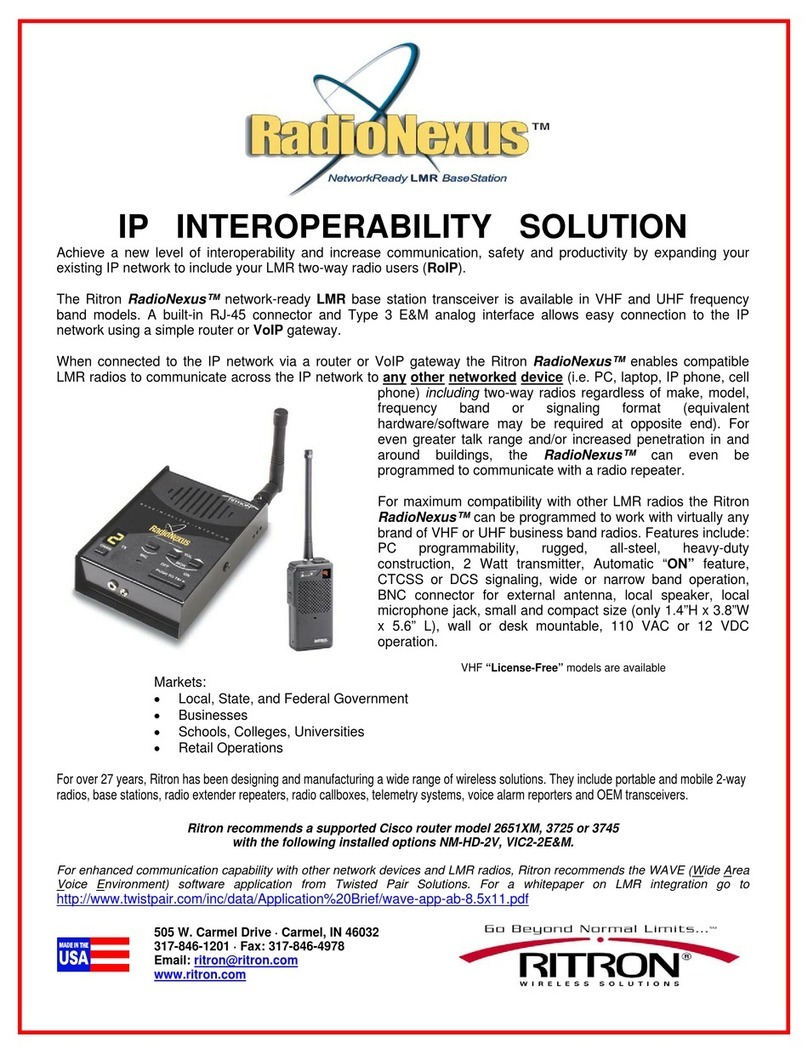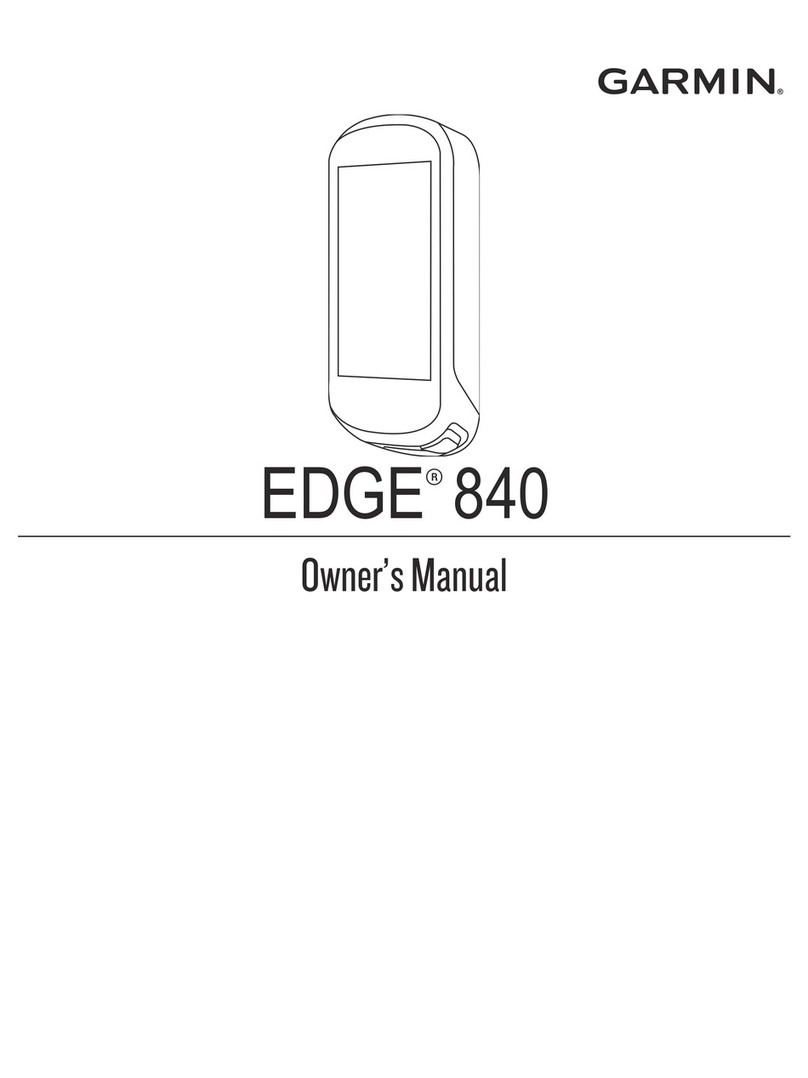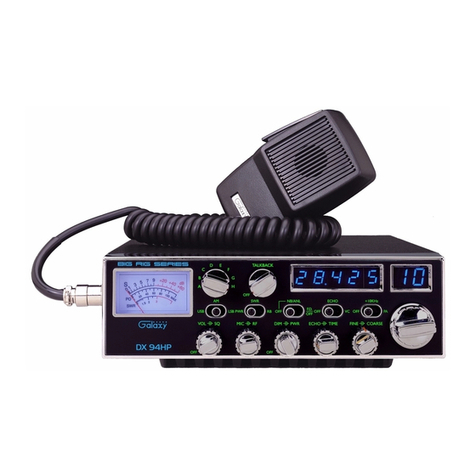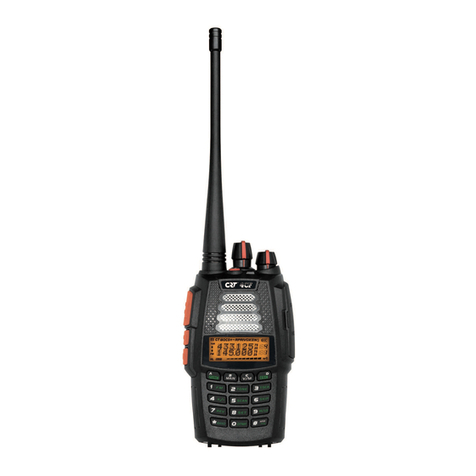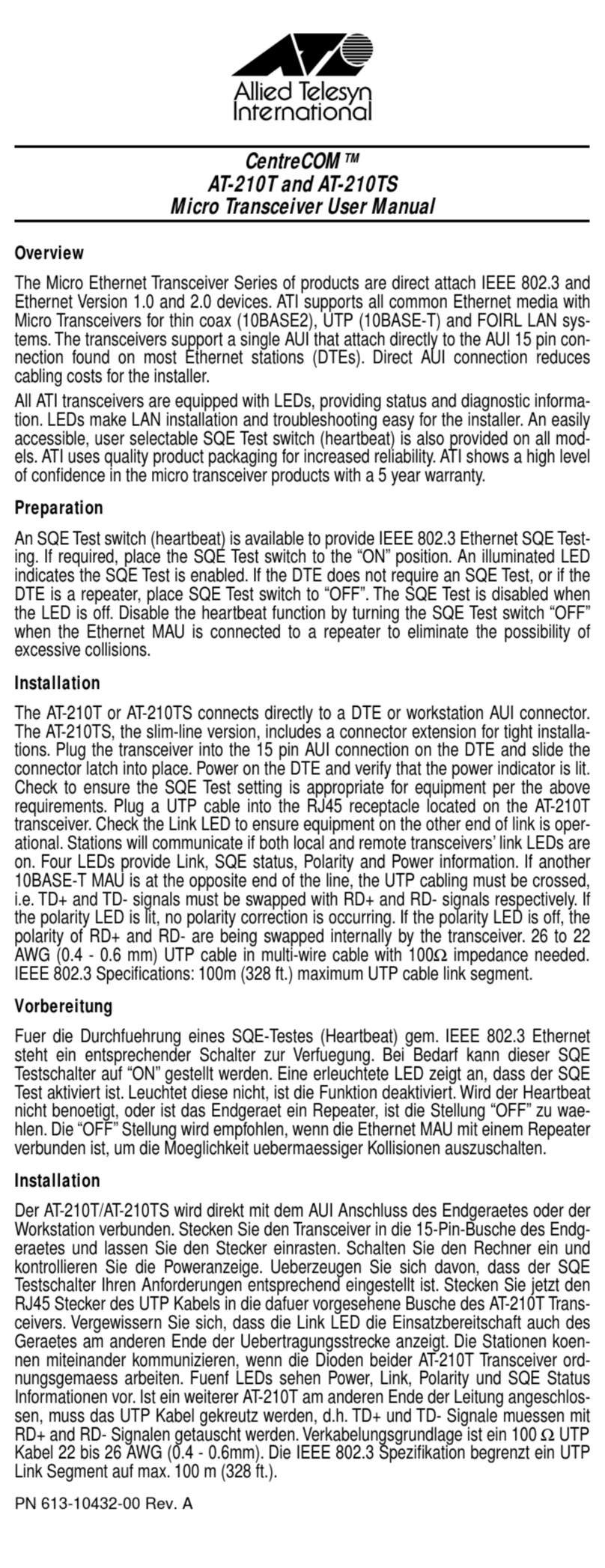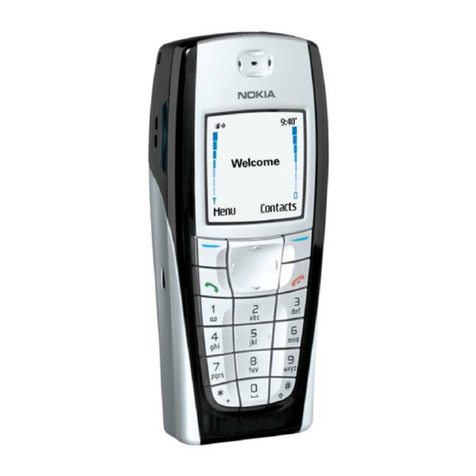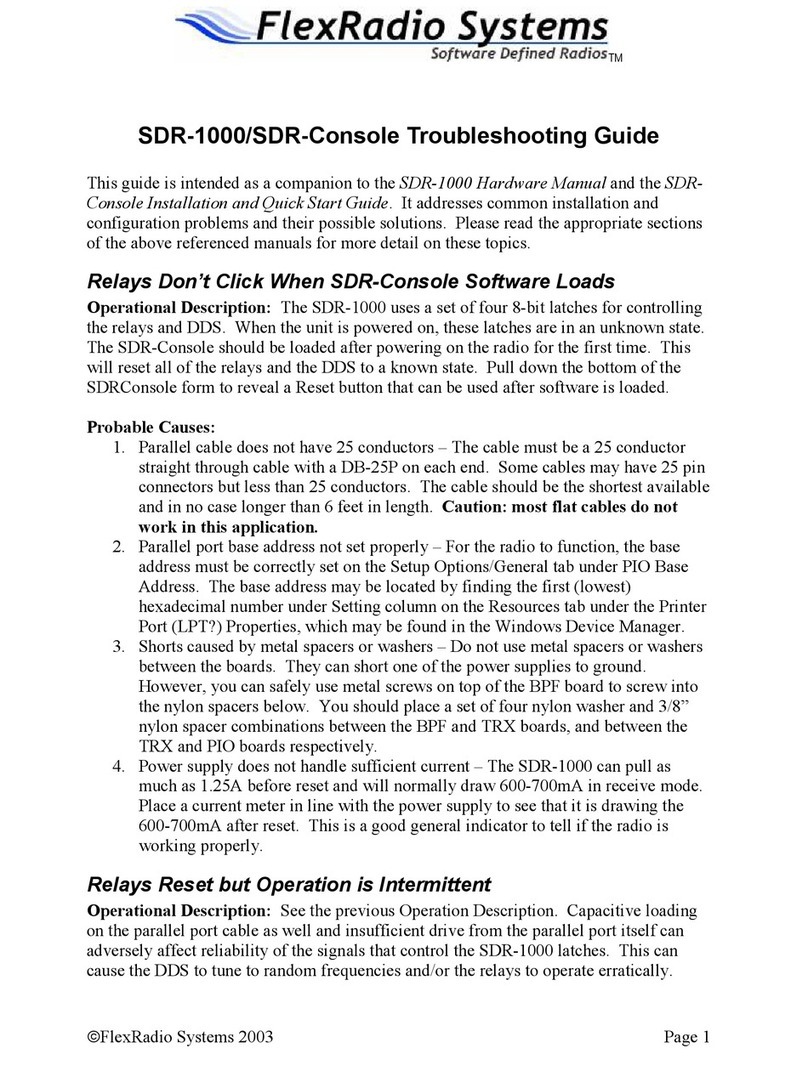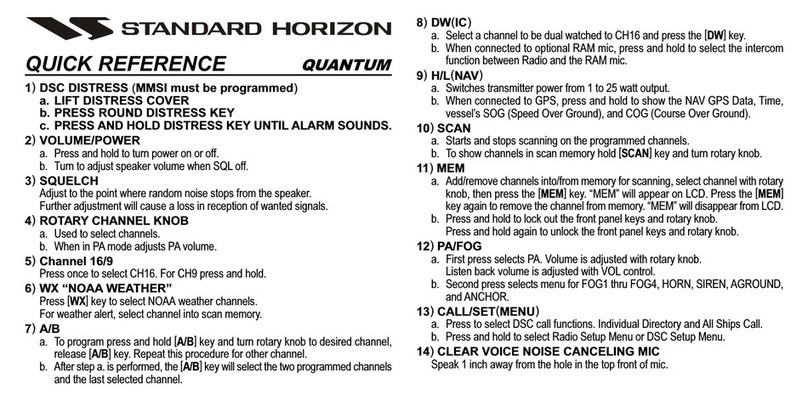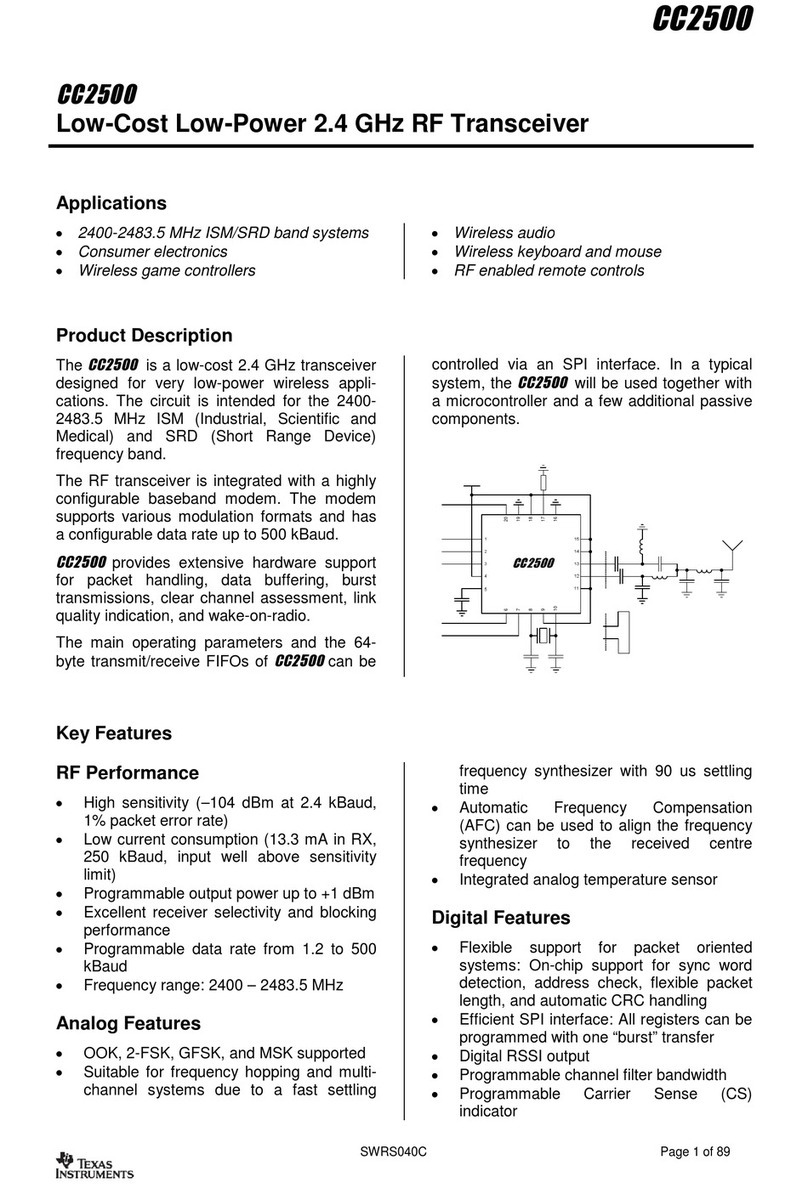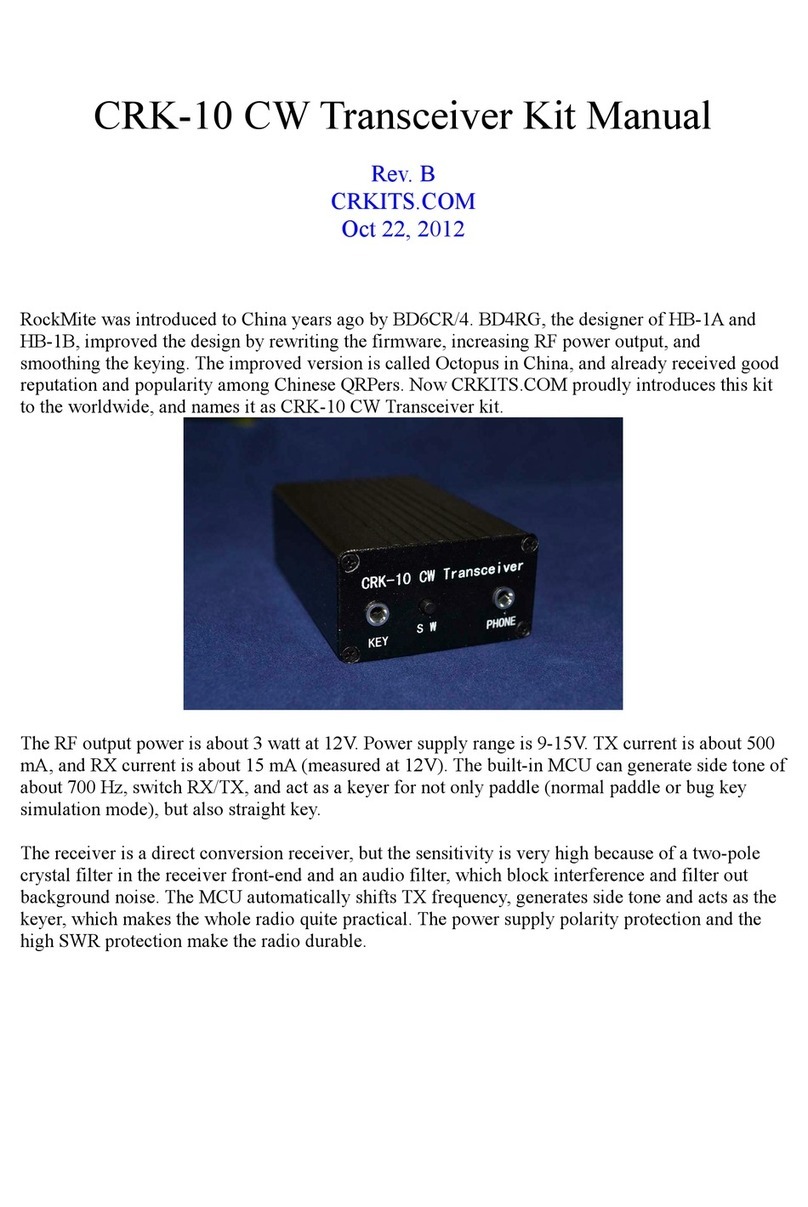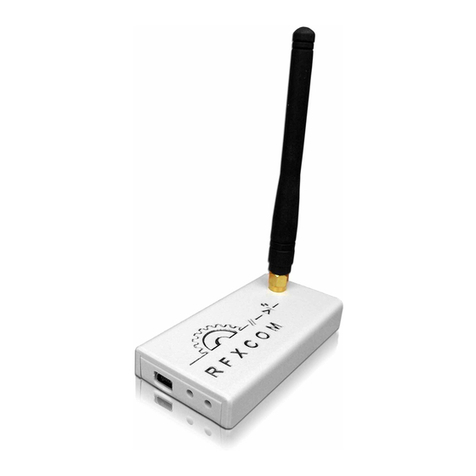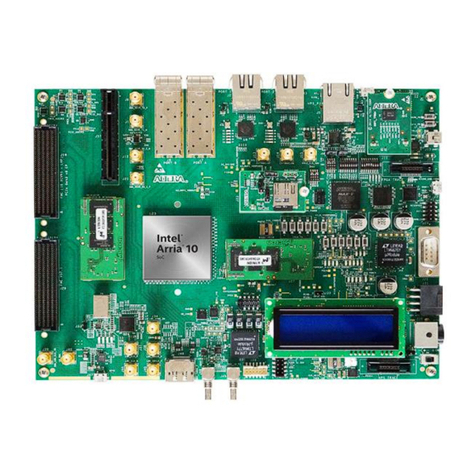Ritron DTXM-NXDN Series Operating and maintenance manual

RITRON, INC. 12-2020
RITRON MODELS DTXM-NXDN SERIES
PROGRAMMABLE
FM TRANSCEIVER MODULES
MAINTENANCE & OPERATING
MANUAL
FOR USE ONLY BY AUTHORIZED SERVICE/MAINTENANCE PERSONNEL

TABLE OF CONTENTS
I DTXM MODULES
1 INTRODUCTION
1.1 GENERAL
1.2 MODEL IDENTIFICATION
1.3 FCC/IC REGULATIONS
2 SPECIFICATIONS
2.1 GENERAL
2.2 TRANSMITTER
2.3 RECEIVER
3 DTXM INPUT/OUTPUT CONNECTOR
4 ACCESSORIES
5 OPERATION
5.1 CHANNEL SELECTION
5.2 POWER SUPPLY VOLTAGE
5.3 CURRENT DRAIN vs SUPPLY VOLTAGE
5.4 DUTY CYCLE/KEY-DOWN LIMITATIONS
5.5 OPERATING MODES
6 PROGRAMMING
6.1 PC PROGRAMMING KIT
6.2 LOADING THE PROGRAMMING SOFTWARE
6.3 COMPUTER SOFTWARE COPYRIGHTS
6.4 USING THE PROGRAMMING SOFTWARE
6.5 PROGRAMMER MENUS
II MAINTENANCE
7 IMPORTANT MAINTENANCE INFORMATION
9 HARDWARE OPTIONS
9.1 CONTROLLER/LOADER BOARD OPTIONS
9.2 RF BOARD OPTIONS


1 INTRODUCTION
1.1 GENERAL
The RITRON DTXM Plus modules are programmable 2-way radios, which operate either in the
VHF or UHF professional FM communications bands as well as a number of other bands in the
220 MHz and 350 MHz region. Each of four channels can be programmed to contain a unique
set of operating frequencies. The DTXM Plus module is made up of two PC boards, an RF board
and a control/loader board. These two boards are enclosed in a metal case with two connectors
on one end; a 50 ohm BNC connector for connection to an antenna and a DB-15 sub-miniature
connector for power and control input/output.
In addition, the RF board is available as a stand-alone unit for system integrators.
1.2 MODEL IDENTIFICATION
The DTXM has a part number in the form of “DTXM-A60-BCDEF”
Where:
A is the major frequency band designator:
1=VHF (136-174 MHz)
2=217-245 MHz
3=340-400 MHz
4=UHF (400-520 MHz)
B is the sub-band designator:
G=340-360 and 400-420
A=420-440
B=430-450
0=136-174, 217-245, 360-380, and 450-470
M=380-400
C=470-490
T=490-512
C is the connector designator:
B=BNC connector
M= MCX connector
S=SMA connector
D designates the channel bandwidth:
S=6.25 kHz
N=12.5 kHz
W=25 kHz
E designates the maximum power level:
3=3 watts
6=6 watts
9=10 watts

F designates the regulator option
I=Internal regulator (10-16 VDC operation with regulated RF power amplifier)
D=No regulator (7.5 VDC operation)
L=RF PA is unregulated, but the remainder of the modem is regulated (10-watt versions)
Example: A DTXM-160-OBN6I would be a VHF module for operation between 136 and 174 MHz
with a BNC RF connector, narrow (12.5 kHz channel spacing) IF bandwidth, 6 watts maximum
output power, and an internal regulator to allow operation from 10 to 15 volts.
1.3 FCC/IC REGULATIONS
1.3.1 LICENSING
For those frequency bands governed by FCC rules, the FCC requires that the radio owner obtain
a station license for his radio before using the equipment to transmit, but does not require an
operating license or permit. The station licensee is responsible for proper operation and
maintenance of his radio equipment, and for ensuring that transmitter power, frequency and
deviation are within the limits specified by the station license. This includes checking the
transmitter frequency and deviation periodically using appropriate methods. Note also, that
wideband operation (25/30 kHz channel bandwidth) may not be permitted.
1.3.2 PRODUCT CERTIFICATION
The DTXM modules are certified by the FCC for operation in the United States and by Industry
Canada for operation in Canada on certain frequency bands and sub-bands for transmission of
either voice or data signals when aligned according to the alignment procedure for the proper
bandwidth and when operated as a complete unit in the metal case. Operation of the RF board
as a stand-alone unit or in combination with any other equipment, in any mode outside the
alignment procedure, or with the clipper filter electronically disabled will require the filing of a new
type acceptance application with the FCC by the user.
1.3.3 SAFETY STANDARDS-RF EXPOSURE
RF ENERGY EXPOSURE AWARENESS AND CONTROL INFORMATION, AND
OPERATIONAL INSTRUCTIONS FOR FCC OCCUPATIONAL USE REQUIREMENTS:
BEFORE USING THIS 2-WAY RADIO, READ THIS IMPORTANT RF ENERGY AWARENESS
AND CONTROL INFORMATION AND OPERATIONAL INSTRUCTIONS TO ENSURE
COMPLIANCE WITH THE FCC’S AND IC’S RF EXPOSURE GUIDELINES.
THIS DEVICE COMPLIES WITH PART 15 OF THE FCC RULES. OPERATION IS SUBJECT TO THE
FOLLOWING TWO CONDITIONS: (1) THIS DEVICE MAY NOT CAUSE HARMFUL INTERFERENCE,
AND (2) THIS DEVICE MUST ACCEPT ANY INTERFERENCE RECEIVED, INCLUDING
INTERFERENCE THAT MAY CAUSE UNDESIRED OPERATION.
NOTE: THE GRANTEE IS NOT RESPONSIBLE FOR ANY CHANGES OR MODIFICATIONS NOT
EXPRESSLY APPROVED BY THE PARTY RESPONSIBLE FOR COMPLIANCE. SUCH
MODIFICATIONS COULD VOID THE USER’S AUTHORITY TO OPERATE THE EQUIPMENT.
NOTICE: This radio is intended for use in general population/uncontrolled conditions, where
users do not have full knowledge of their exposure and cannot exercise control over their
exposure to meet FCC/IC limits.

This 2-way radio uses electromagnetic energy in the radio frequency (RF) spectrum to provide
communications between two or more users over a distance. It uses radio frequency (RF) energy
or radio waves to send and receive calls. RF energy is one form of electromagnetic energy. Other
forms include, but are not limited to, electric power, sunlight and x-rays. RF energy, however,
should not be confused with these other forms of electromagnetic energy, which when used
improperly can cause biological damage. Very high levels of x-rays, for example, can damage
tissues and genetic material.
Experts in science, engineering, medicine, health and industry work with organizations to develop
standards for exposure to RF energy. These standards provide recommended levels of RF
exposure for both workers and the general public. These recommended RF exposure levels
include substantial margins of protection. All 2-way radios marketed in North America are
designed, manufactured and tested to ensure they meet government established RF exposure
levels. In addition, manufacturers also recommend specific operating instructions to users of 2-
way radios. These instructions are important because they inform users about RF energy
exposure and provide simple procedures on how to control it. Please refer to the following
websites for more information on what RF energy exposure is and how to control your exposure
to assure compliance with established RF exposure limits.
http://www.fcc.gov/oet/rfsafety/rf-faqs.html
http://www.osha.gov/SLTC/radiofrequencyradiation/index.html
Federal Communications Commission Regulations:
The FCC rules require manufacturers to comply with the FCC RF energy exposure limits for
mobile 2-way radios before they can be marketed in the U.S. When 2-way radios are used as a
consequence of employment, the FCC requires users to be fully aware of and able to control their
exposure to meet occupational requirements. Exposure awareness can be facilitated by the use
of a label directing users to specific user awareness information.
The DTXM 2-way radio has an RF exposure product label. Also, this DTXM manual includes
information and operating instructions required to control your RF exposure and to satisfy
compliance requirements.
Compliance with RF Exposure Standards:
The DTXM two-way radio is designed and tested to comply with a number of national and
international standards and guidelines (listed below) regarding human exposure to radio
frequency electromagnetic energy. This radio complies with the IEEE and ICNIRP exposure limits
for occupational/controlled RF exposure environment at duty factors of up to 50% talk and 50%
listen and is authorized by the FCC for occupational use. In terms of measuring RF energy for
compliance with the FCC exposure guidelines, your radio antenna radiates measurable RF
energy only while it is transmitting (during talking), not when it is receiving (listening) or in standby
mode.
The DTXM two-way radio complies with the following RF energy exposure standards and
guidelines, and when used as directed, the DTXM radio is designed to comply with ISED RSS-
102 Exposure Limits. In addition, the DTXM radio is designed to comply with the following
Standards and Guidelines:
• United States Federal Communications Commission, Code of Federal Regulations; 47 CFR JJ
1.1307, 1.1310, 2.1091 and 2.1093.
• American National Standards Institute (ANSI) / Institute of Electrical and Electronic Engineers
(IEEE) C95. 3-2003.
• Institute of Electrical and Electronic Engineers (IEEE) C95.3-2003 Edition.
Copyright Telecommunications Industry Association
To control exposure to yourself and others and ensure compliance with the general
population/uncontrolled environment exposure limits always adhere to the following procedures:

Guidelines:
• User awareness instructions should accompany device when transferred to other users.
• Do not use this device if the operational requirements described herein are not met.
Instructions:
• Transmit no more than the rated duty factor of 50% of the time. To transmit (talk or send data),
assert the PTT input pin. To receive calls, un-assert the PTT input. Transmitting 50% of the time,
or less, is important because this radio generates measurable RF energy exposure only when
transmitting (in terms of
measuring for standards compliance).
• Transmit only when people are at least the recommended minimum lateral distance away, as
shown in Table 1, from a properly installed according to installation instructions, externally-
mounted antenna.
NOTE - Table 1 lists the recommended minimum lateral distance for bystanders in an
uncontrolled environment from transmitting types of antennas (i.e., monopoles over a ground
plane, or dipoles) at several different ranges of rated radio power for mobile radios installed on a
vehicle.
Table 1. Rated Power and Recommended Lateral Distance for quarter-wave, unity gain, ground
plane antenna:
Rated Power of DTXM Recommended Minimum Lateral
2-way Radio Distance from Transmitting Antenna
6 watts 8 inches (22 cm)
Antennas
• Install antennas taking into account the recommended minimum lateral distances listed above.
These antenna installation guidelines are limited to antennas with appropriate ground planes. The
antenna installation should additionally be in accordance with:
a.) The requirements of the antenna manufacturer/supplier.
b.) Instructions in this manual including minimum antenna cable lengths.
c.) Antennas other than those shown in Table 1 must be tested with the DTXM module
for RF exposure compliance in the environment in which it is to be used per the FCC’s
OET Bulletin 65, Edition 97-01 or Industry Canada RSS-102.
• Use only a VHF quarterwave antenna or equivalent antenna or other antennas as described
above. Unauthorized antennas, modifications, or attachments could damage the radio and may
violate FCC regulations.
Approved Accessories
• This radio has been tested and meets the FCC RF exposure guidelines when used with the
Ritron accessories supplied or designated for this product. Use of other accessories may not
ensure compliance with the FCC’s RF exposure guidelines, and may violate FCC regulations.
• For a list of Ritron approved accessories see this user manual, or visit the following website
which lists approved accessories: www.ritron,com
Contact Information:
For additional information on exposure requirements or other information, contact Ritron at (317)
846-1201 or at www.ritron.com.

INFORMATIONS DE SENSIBILISATION ET DE CONTRÔLE À L'EXPOSITION AUX ÉNERGIES RF, ET
INSTRUCTIONS OPÉRATIONNELLES POUR LES EXIGENCES D'UTILISATION PROFESSIONNELLE
DE LA FCC:
AVANT D'UTILISER CETTE RADIO À 2 VOIES, LISEZ CES INFORMATIONS IMPORTANTES SUR LA
SENSIBILISATION ET LE CONTRÔLE À L'ÉNERGIE RF ET LES INSTRUCTIONS
OPÉRATIONNELLES POUR VOUS ASSURER LA CONFORMITÉ AVEC LES DIRECTIVES
D'EXPOSITION AUX RF DE LA FCC ET DES IC.
CET APPAREIL EST CONFORME À LA PARTIE 15 DES RÈGLES FCC. LE FONCTIONNEMENT EST
SOUMIS AUX DEUX CONDITIONS SUIVANTES: (1) CET APPAREIL NE PEUT PAS CAUSER DES
INTERFÉRENCES DANGEREUSES, ET (2) CET APPAREIL DOIT ACCEPTER TOUTE
INTERFÉRENCE REÇUE, Y COMPRIS LES INTERFÉRENCES POUVANT CAUSER UN
FONCTIONNEMENT INDÉSIRABLE.
REMARQUE: LE BÉNÉFICIAIRE N'EST PAS RESPONSABLE DES CHANGEMENTS OU
MODIFICATIONS NON EXPRESSÉMENT APPROUVÉS PAR LA PARTIE RESPONSABLE DE LA
CONFORMITÉ. DE TELLES MODIFICATIONS POURRAIENT ANNULER L'AUTORITÉ DE
L'UTILISATEUR DE FAIRE FONCTIONNER L'ÉQUIPEMENT.
AVIS: Cette radio est destinée à être utilisée dans la population générale / dans des conditions non
contrôlées, où les utilisateurs n'ont pas une connaissance complète de leur exposition et ne peuvent pas
contrôler leur exposition pour respecter les limites FCC / IC.
Cette radio bidirectionnelle utilise l'énergie électromagnétique dans le spectre des radiofréquences (RF)
pour fournir des communications entre deux ou plusieurs utilisateurs à distance. Il utilise l'énergie des
radiofréquences (RF) ou des ondes radio pour envoyer et recevoir des appels. L'énergie RF est une
forme d'énergie électromagnétique. D'autres formes comprennent, mais sans s'y limiter, l'énergie
électrique, la lumière du soleil et les rayons X. L'énergie RF, cependant, ne doit pas être confondue avec
ces autres formes d'énergie électromagnétique qui, lorsqu'elles sont mal utilisées, peuvent causer des
dommages biologiques. Des niveaux très élevés de rayons X, par exemple, peuvent endommager les
tissus et le matériel génétique.
Des experts en science, ingénierie, médecine, santé et industrie travaillent avec des organisations pour
développer des normes d'exposition à l'énergie RF. Ces normes fournissent des niveaux recommandés
d'exposition aux RF pour les travailleurs et le grand public. Ces niveaux d'exposition RF recommandés
incluent des marges de protection substantielles. Toutes les radios bidirectionnelles commercialisées en
Amérique du Nord sont conçues, fabriquées et testées pour garantir qu'elles respectent les niveaux
d'exposition aux RF établis par le gouvernement. En outre, les fabricants recommandent également des
instructions d'utilisation spécifiques aux utilisateurs de radios bidirectionnelles. Ces instructions sont
importantes car elles informent les utilisateurs sur l'exposition à l'énergie RF et fournissent des
procédures simples sur la façon de la contrôler. Veuillez consulter les sites Web suivants pour plus
d'informations sur ce qu'est l'exposition à l'énergie RF et comment contrôler votre exposition pour assurer
la conformité avec les limites d'exposition RF établies.
http://www.fcc.gov/oet/rfsafety/rf-faqs.html
http://www.osha.gov/SLTC/radiofrequencyradiation/index.html
Règlements de la Federal Communications Commission:
Les règles de la FCC exigent que les fabricants se conforment aux limites d'exposition à l'énergie RF de
la FCC pour les radios mobiles bidirectionnelles avant de pouvoir être commercialisées aux États-Unis. et
capables de contrôler leur exposition pour répondre aux exigences professionnelles. La sensibilisation à
l'exposition peut être facilitée par l'utilisation d'une étiquette orientant les utilisateurs vers des informations
spécifiques de sensibilisation des utilisateurs.
La radio bidirectionnelle DTXM est conçue et testée pour se conformer à un certain nombre de normes et
directives nationales et internationales (énumérées ci-dessous) concernant l'exposition humaine à
l'énergie électromagnétique de radiofréquence. Cette radio est conforme aux limites d'exposition IEEE et
ICNIRP pour un environnement d'exposition professionnelle / contrôlée aux RF à des facteurs de service

allant jusqu'à 50% de conversation et 50% d'écoute et est autorisée par la FCC pour une utilisation
professionnelle. En termes de mesure de l'énergie RF pour se conformer aux directives d'exposition de la
FCC, votre antenne radio émet de l'énergie RF mesurable uniquement lorsqu'elle émet (pendant la
conversation), pas lorsqu'elle reçoit (écoute) ou en mode veille.
La radio bidirectionnelle DTXM est conforme aux normes et directives d'exposition à l'énergie RF
suivantes, et lorsqu'elle est utilisée selon les instructions, la radio DTXM est conçue pour se conformer
aux limites d'exposition RSS-102 d'ISDE. De plus, la radio DTXM est conçue pour se conformer aux
normes et directives suivantes:
• Commission fédérale des communications des États-Unis, Code of Federal Regulations; 47 CFR JJ
1.1307, 1.1310, 2.1091 et 2.1093.
• Institut national américain des normes (ANSI) / Institut des ingénieurs électriques et électroniques
(IEEE) C95. 3-2003.
• Édition C95.3-2003 de l'Institut des ingénieurs électriciens et électroniciens (IEEE).
Copyright Association de l'industrie des télécommunications
Pour contrôler l'exposition à vous-même et aux autres et garantir le respect des limites d'exposition de la
population générale / de l'environnement non contrôlé, respectez toujours les procédures suivantes:
Des lignes directrices:
• Les instructions de sensibilisation de l'utilisateur doivent accompagner l'appareil lors du transfert à
d'autres utilisateurs.
• N'utilisez pas cet appareil si les exigences opérationnelles décrites ici ne sont pas satisfaites.
Instructions:
• Ne transmettez pas plus que le facteur de service nominal de 50% du temps. Pour transmettre (parler
ou envoyer des données), confirmez la broche d'entrée PTT. Pour recevoir des appels, désactivez
l'entrée PTT. La transmission à 50% du temps, ou moins, est importante car cette radio génère une
exposition à l'énergie RF mesurable uniquement lors de la transmission (en termes de
mesure de la conformité aux normes).
• Ne transmettez que lorsque les personnes se trouvent au moins à la distance latérale minimale
recommandée, comme indiqué dans le tableau 1, d'une antenne montée à l'extérieur correctement
installée conformément aux instructions d'installation.
NOTE - Le Tableau 1 énumère la distance latérale minimale recommandée pour les spectateurs dans un
environnement non contrôlé par rapport aux types d'antennes de transmission (c'est-à-dire monopôles
sur un plan de masse ou dipôles) à plusieurs plages de puissance radio nominale pour les radios mobiles
installées sur un véhicule.
Tableau 1. Puissance nominale et distance latérale recommandée pour l'antenne quart d'onde, gain
unitaire, plan de masse:
Puissance nominale latérale minimale recommandée
de DTXM Distance radio bidirectionnelle de l'antenne émettrice
6 watts 8 pouces (22 cm)

Antennes
• Installez les antennes en tenant compte des distances latérales minimales recommandées ci-dessus.
Ces directives d'installation d'antenne sont limitées aux antennes avec des plans de masse appropriés.
L'installation de l'antenne doit en outre être conforme à:
a.) Les exigences du fabricant / fournisseur d'antenne.
b.) Les instructions de ce manuel, y compris les longueurs minimales de câble d'antenne.
c.) Les antennes autres que celles indiquées dans le tableau 1 doivent être testées avec le module DTX
pour vérifier la conformité d’exposition RF dans l’environnement dans lequel il doit être utilisé,
conformément au bulletin OET 65 de la FCC, édition 97-01 ou à l’industrie Canada RSS-102.
Utilisez uniquement une antenne quart d'onde VHF ou une antenne équivalente ou d'autres antennes
comme décrit ci-dessus. Les antennes, modifications ou accessoires non autorisés peuvent endommager
la radio et enfreindre les réglementations FCC.
Accessoires approuvés
• Cette radio a été testée et répond aux directives d'exposition RF de la FCC lorsqu'elle est utilisée avec
les accessoires Ritron fournis ou désignés pour ce produit. L'utilisation d'autres accessoires peut ne pas
garantir la conformité avec les directives d'exposition RF de la FCC et peut enfreindre les
réglementations FCC.
• Pour une liste des accessoires approuvés par Ritron, consultez ce manuel de l'utilisateur ou visitez le
site Web suivant qui répertorie les accessoires approuvés: www.ritron, com
Informations de contact:
Pour plus d'informations sur les exigences d'exposition ou d'autres informations, contactez Ritron au
(317) 846-1201 ou sur www.ritron.com.

2 SPECIFICATIONS
2.1 GENERAL
DTXM-160-0
FCC ID: AIERIT51-16006 (Pending)
IC ID: 1084A-RIT5116006 (Pending)
FCC Rule Parts 90
Industry Canada Rule Parts RSS-119
Frequency Range
DTXM-160-0 136-174 MHz
Number of Channels 4
Transmit/Receive Spacing Up to the span of the sub-band
Mode of Operation Simplex or Half Duplex
Frequency Control PLL Synthesizer
Channel Increment (Synthesizer step size)
DTXM-160 2.5 kHz/3.125 kHz
6.25 kHz
Emissions Bandwidth
Very narrow mode 4.0-4.8 kHz depending upon modulation
Narrow Mode 10 kHz
Frequency Stability
-30 C to +50 C +/-1.0 ppm
-40 C to +60 C +/-1.5 ppm
Supply Voltage
3 and 6 watt versions
w/o internal regulator 7.5 VDC
w internal regulator 11 to 16 VDC
RF Input/Output Connector BNC standard
Power/Data Interface 15 pin subminiature D type
Operating Temperature -30 to +60 C
Maximum Dimensions (L x W x H) 3.6” x 2.3” x 1.0” including connectors
Weight 6 oz.

2.2 TRANSMITTER
Operating Bandwidth Up to the span of the sub-band
RF Output Power(internally adjustable)
6 watt version 1 to 6 watts (2.5 watts min.
recommended)
Duty Cycle 5 to 100 % depending upon voltage and
power level (see chart elsewhere in
manual)
RF Load Impedance 50 ohms
Modulation Distortion (per TIA/EIA 603) 5 % max.
Modulation Frequency Response (+1/-3 dB, ref 1 kHz)
Narrowband versions:
w pre-emphasis 400 Hz to 2500 Hz
w/o pre-emphasis 50 Hz to 2700 Hz
Very narrowband versions:
w/o pre-emphasis 50 Hz to 1200 Hz
Transmitter Attack Time: 10 ms max
Spurious and Harmonics -25 dBm max.
FM Hum and Noise
Very narrow channel (5/6.25/7.5 kHz) operation 40 dB min.
Narrow channel (12.5/15 kHz) operation 45 dB min.
Group Delay Variation (Within Frequency Response) 5 us max.
Current Drain Depends upon supply voltage and
regulator
options (see chart elsewhere in
manual).
AUX IN adjustment range (60% rated dev.)
w pre-emphasis (@ 1 kHz) 200 to 1000 mV rms
w/o pre-emphasis (flat) 40 to 300 mV rms

2.3 RECEIVER
Operating Bandwidth Up to span of the sub-band
Sensitivity (12 dB SINAD @ 1 kHz w de-emphasis) 0.25 uV (-119.0 dBm)
RF Input Impedance 50 ohms nominal
Adjacent Channel Selectivity
+/-6.25 kHz w very narrow IF 45 dB min.
+/- 12.5 kHz w narrow IF 60 dB min.
Spurious and Image Rejection
IF/2 60 dB min.
Image & other 70 dB min.
Intermodulation Rejection 68 dB min.
FM Hum and Noise
Very narrow channel (5/6.25/7.5 kHz) operation 40 dB min.
Narrow channel (12.5/15 kHz) operation 45 dB min.
Conducted Spurious -57 dBm max.
Receive Attack Time (transmit to receive) 10 ms max.
Carrier Detect Attack Time 5 ms max.
Audio Distortion 5 % max.
Audio Response (+1/-3 dB, ref 1 kHz)
Narrowband versions:
w de-emphasis 400 Hz to 2500 Hz
w/o de-emphasis 100 Hz to 3500 Hz
Very narrowband versions:
w/o de-emphasis 100 Hz to 1500 Hz
Receive Current Drain Depends upon supply voltage options
(see chart elsewhere in manual).
AUX OUT Adjustment Range (60 % rated dev.)
w de-emphasis (@ 1 kHz) 50 to 500 mV rms open circuit
w/o de-emphasis (@1 kHz) 250 to 1800 mV rms open circuit

3 DTXM INPUT/OUTPUT CONNECTORS
DB-15 Connector Pinout
Pin Number Name Description Comments
1 Audio/Mic In External Audio Input Wideband input for data.
2 Audio Out Auxiliary Output Wideband output for data.
3 Speaker Audio PA Output Output of audio PA.
4 CS0 Channel Select low bit
5 RSSI Receive Signal Strength Analog Receive Signal Strength
Indicator
6 Raw Supply Supply Voltage Input +10 to +16VDC Input.
7 DISC Out
8 RD Receive Program Data
9 TD Transmit Program Data
10. CTS Clear To Send Asserted when
transmitter can accept
modulation.
11. CS1 Channel Select mid bit
12. Test/PTT Push To Talk Activates transmitter.
13. CD Carrier Detect Carrier detect output.
14. RTS Request To Send
15. GND Ground Negative supply point and
reference for all inputs.
Pinout Description
Pin Number Description
1 AUDIO/MIC IN -This is the main audio input for modulation. The gain through
this input to the modulator is programmable, as is the use of pre-emphasis. This
signal passes through the clipper and clipper filter.
2 AUDIO OUT-This is the broadband output of the receiver. The gain from the
receiver to the output is programmable, as is the use of de-emphasis. The
choice of AC or DC coupling from the RF board discriminator is also
programmable. The coupling at the output of this pin is AC coupled, however. It
can be converted to DC coupling with internal hardware modifications. Note:
The output impedance is approximately 600 ohms. Therefore, it is not
recommended that this output drive loads with less than 1000 ohms unless
the resultant voltage drop is accounted for.
3 SPEAKER -This is the output of the audio power amplifier. This output can drive
up to 100 milliwatts into an 8 ohm load. The output level can be controlled by
programming. De-emphasis can be applied to this output, but not independently
of the AUDIO OUT output. Note that this output level varies with the adjustment
via the programmer of the AUX OUT level. Thus, the AUX OUT level should be
set first before adjusting the AUDIO OUT level.

4 CS0-Least significant bit of the channel select lines. Active high 5 volt
TTL/CMOS level. Internal 10 kpull-up to +5 volts.
Channel CS1 CS0
1 0 0
2 0 1
3 1 0
4 1 1
0 = Logic low
1 = Logic high
Note: Due to the internal pull-up resistors, the unit defaults to channel 8 if the
channel pins are left open (unconnected). Channel 4 would be the nominal
channel when the Ritron programmer is connected.
5 RSSI- This is an analog output whose amplitude is proportional to the signal
strength of the received signal. The voltage at this pin varies from about 1.6 VDC
for a -130 dBm signal to about 4 VDC for signals at or above -60 dBm.
6 RAW SUPPLY- Supply voltage input. +10VDC to +16VDC.
7 DISC OUT-
8 RD- Connect via RITRON DTXP-PCPK PC Programming Kit to computer for
programming the unit.
9 TD-Connect via RITRON DTXP-PCPK PC Programming Kit to computer for
programming the unit.
10 CTS-Clear-To-Send output from the unit which indicates that the unit is
transmitting a carrier at the correct frequency and power level and is ready to
accept an input signal to be transmitted. This output would normally become
asserted in response to a PTT RTS (see pin 14 description below) activation.
The polarity of this output can be programmed. The output is active low 5 volt
logic with an internal 10 k ohm pull-up to 5 volts. It can source up to 10 mA when
low.
11 CS1-Most significant bit of the channel select lines.
12 TEST/PTT- Push to Talk/Request to Send. This input commands the unit to
transmit. Input levels are TTL/CMOS; polarity may be programmed. Internal 10
kpull-up to +5 volts.
13 CD-Carrier detect output. This output becomes asserted when a signal strong
enough to exceed the programmed squelch threshold is present. This output is
not affected by the RX MON input. The polarity can be programmed. The output
is active low 5 volt logic with an internal 10 kpull-up to +5 volts. It can source
up to 10 mA when low.
14 RTS- This RS-232 input pin is asserted by the host computer or device to
indicate that it has data to be transmitted by the modem. If the modem is able to
accept the data, the CTS pin will be asserted in response.
15 GND-System ground. All signals and voltages are referenced to this input. The
negative side of the power supply should connect here.

4 ACCESSORIES
Note: Programming kits are for use by authorized service/maintenance personnel only.
The Programming Kit for DTXM Plus radios (via compatible computer) is model DTXM-NXDN-
PCPK-1. It includes:
1) Programming Software, DTXM-NXDN-PCPS-1.
2) DB-9 to DB-15 connector cable with power cable.
3) 9-Pin to USB Adapter, 2147C002.
Factory programming of channels and features is also optional. Contact the factory for details.

5 OPERATION
5.1 CHANNEL SELECTION
The DTXM module supports eight channels. The desired channel is chosen via pins 4 and 11 of
the 15 pin connector as shown:
Channel CS1 CS0
1 0 0
2 0 1
3 1 0
4 1 1
0 = Logic low
1 = Logic high
Note: Due to the internal pull-up resistors, the unit defaults to channel 8 if the channel pins are
left open (unconnected). Channel 4 would be the nominal channel when the Ritron
programmer is connected.
A change in the channel selection in receive will cause the receiver to operate on the new
channel. In transmit, however, the channel selection is only checked upon a push-to-talk
activation. Changes in channel during transmit will not change the transmit operating channel of
the unit until the unit is cycled from transmit to receive and back to transmit.
5.2 POWER SUPPLY VOLTAGE
The DTXM-160 unit uses a 7.5 volt RF power module. Two supply voltage options are available
for these units depending upon whether the control/loader board has a regulator installed. If a
regulator is not installed, the voltage should be 7.5 volts +/-10 %. This voltage should be “clean”
and preferably regulated since the RF power module is powered directly from this source.
Variations in voltage will cause variations in transmitted output power. Conversely, if the
control/loader board has a regulator installed, the supply voltage can be at any voltage between
11 and 16 volts. The output power will vary with supply voltage. Switching power supplies can
be used, but in models without the internal regulator, care must be taken that the output
waveform is low noise. Also, the module antenna should never be placed near an unshielded
switching power supply.
5.3 CURRENT DRAIN VS SUPPLY VOLTAGE
The current drain of the module is a function of the supply voltage, the RF output in transmit and
the regulator option. The internal 7.5-volt regulator is a switching type such that the current drain
actually decreases with an increase in supply voltage. Typical current drain values are shown in
the table below:
Receive Mode
Supply Voltage Internal Regulator Current Drain
7.5 V No 130 mA
11.0 V Yes 100 mA
12.5 V Yes 90 mA
16.0 V Yes 75 mA
Transmit Mode –1 watt output power
Supply Voltage Internal Regulator Current Drain
7.5 V No 1.2 A
11.0 V Yes 0.9 A
12.5 V Yes 0.7 A
16.0 V Yes 0.5 A

Warning: Although the output power can be set as low as 1 watt, and the module is
certified as low as 1 watt, operation below 2.5 watts output power is not recommended. At
low power levels, the output power can vary by 50% or more with variations in ambient
temperature.
Transmit Mode –3 watt output power
Supply Voltage Internal Regulator Current Drain
7.5 V No 1.8 A
11.0 V Yes 1.4 A
12.5 V Yes 1.2 A
16.0 V Yes 0.9 A
Transmit Mode –6 watt output power
Supply Voltage Internal Regulator Current Drain
7.5 V No 2.5 A
11.0 V Yes 2.1 A
12.5 V Yes 2.0 A
16.0 V Yes 1.5 A
5.4 DUTY CYCLE/KEY-DOWN LIMITATIONS
The major heat generating component within the modules is the RF power amplifier which has a
maximum temperature limit that should not be exceeded. In addition, the temperature within the
module itself must be kept below the maximum temperature of the reference oscillator to ensure
that regulatory frequency stability limits are observed. As a result, depending upon the RF output
power, the supply voltage, and the ambient temperature, limits upon the average transmit duty
cycle and the maximum continuous transmitter on time exist. These limits are summarized below
for operation in still air:
Ambient Temperature (C) Duty Cycle (%) Key-Down Time (s)
3 watts RF output 25 30 45
50 5 10
6 watts RF output 25 20 30
50 3 5
10 watts RF output 25 20 15
(DTXM-460 Only) 50 3 5
Blowing air across the unit and/or adding a heat sink to the rear of the unit where the PA module
is located can significantly improve the duty cycle/key-down times. Ritron offers an option where
the case screws at the rear of the module are longer allowing heat sinks to be attached. Also, a
fan option is available from Ritron which can significantly increase the duty cycle, up to 100% at
room temperature in some cases. Contact Ritron for additional information on these options and
special instructions on attaching heat sinks without compromising the mechanical integrity of the
RF PA module.

5.5 OPERATING MODES
5.5.1 RECEIVE
Carrier Detect and Squelch Operation
The DTXM is a transceiver; i.e. it can receive and transmit, although not at the same time. A
carrier detect system exists within the unit to detect the presence of a carrier which controls the
logic state of the DCD (data carrier detect) output. The RF levels at which this output changes
state are programmable. In addition, the unit may be programmed such that the audio outputs,
AUDIO OUT and AUX OUT, are muted (squelched) in conjunction with DCD operation. In units
where squelch operation has been enabled, the RX MON input can be used to override a
squelched condition. The DCD output is not affected by the RX MON operation.
Receiver Audio Outputs
Two receiver audio outputs are present on the DTXM module. The AUX OUT is a general
purpose output which can have pre-emphasis enabled or bypassed. Its gain can be controlled
and its output is designed to drive 1000 ohm or higher loads. The coupling from the discriminator
on the RF board may be set to AC or DC by the programmer. DC coupling allows for internal
bandwidth to extend to DC, but if a high gain value is chosen for the AUX OUT, clipping may
occur on the waveform due to discriminator voltage offsets. AC coupling removes this issue. The
output stage is AC coupled, but can be modified for DC coupling. This requires replacing a
coupling capacitor with a zero-ohm resistor. Contact Ritron for details on this modification. The
AUDIO OUT is always de-emphasized, but its gain can be programmed. This output can drive 8-
ohm speaker-type loads. In the programmer menu, there is provision to set both the AUX OUT
levels and the AUDIO OUT levels. However, the AUDIO OUT level is dependent upon the AUX
OUT level. Therefore, the AUX OUT level should be set before setting the AUDIO OUT level.
5.5.2 TRANSMIT
PTT Operation
The transmitter is activated by placing the PTT/RTS (Push-To-Talk/Request-To-Send) input in its
asserted state. This state is programmable. If the unit is to operate in simplex (transmitter and
receiver on the same frequency), one should check for activity on the channel before transmitting.
This can be done by checking the state of the DCD output. In addition, the unit can be
programmed so that transmit operation is inhibited if the DCD threshold has been exceeded
(busy channel lockout option).
CTS Output
The CTS (Clear To Send) output goes to its active state when the unit has powered up the
transmitter, it is locked on the correct transmit frequency, and it is ready to accept modulation.
This output may be used to signal a modem to start transmitting data. If this output is not used, to
avoid losing data, a delay of at least 12 ms is required between PTT/RTS activation and the
application of data.
Transmitter Audio Inputs
Two mutually exclusive audio inputs are available on the DTX module. The AUX IN is a general-
purpose input with an input impedance greater than 50 k-ohms and is capacitive coupled with a
lower roll-off frequency of about 25 Hz. The MIC IN input is a higher gain input designed for
connection to a standard electret or dynamic microphone. The choice of the input source is made
via the programmer. The selected signal can be set for a pre-emphasized or flat audio response
and the gain can also be set. At maximum gain, the AUX IN signal input can achieve 60% rated
modulation with about 25 mv rms input signal while the MIC IN signal can achieve the same
modulation with 4 mv rms in the low gain position and 0.5 mv in the high gain position.
High/Low Power
High and low power levels can be programmed into the unit on a channel by channel basis. High
power is selected by placing the CSN input at a logic high state. Placing the CSN input at a logic
low state chooses low power. The CSN input has an internal pull-up resistor; it will assume the
high state and the module will be set for high power when left unconnected.

Specialized Modem Operation
Modems designed to achieve the highest data rates possible in a radio channel may require a
direct DC connection to the modulation path and the removal of the limiter-filter. In order to
receive FCC Certification, the DTX module must either be tested and approved with a specific
modem connected to the transmitter, or a modulation limiter and limiter-filter must always be
present in the transmit modulator audio path with the modulation inputs AC coupled. To allow for
the most flexibility for the end user, the unit was certified as a stand-alone unit. It is possible, with
hardware modifications and special programming software (not supplied with the unit), to DC
couple the AUX IN input and/or defeat the limiter-filter. The modulation limiter would still be in
place, but the deviation of the DTX module could be set such that the modulation limit within the
DTX module is never reached. The deviation would be set by the modem level and the AUX IN
gain setting. The end user/system integrator would then bear the responsibility of obtaining
certification or operating in a frequency band where certification is not required. Contact RITRON
for details. Note: Most modems will connect directly to the DTX without requiring any
special modifications or programming.
Antenna Placement
The DTX module is enclosed in a metal housing for RF shielding. However, RF emitting sources
located very close (less than 12 inches) to the unit can at times affect its operation. It is not
recommended that an antenna be connected directly to the module’s BNC connector unless the
RF output power is set for less than 5 watts or the module is placed within another RF-tight
enclosure.
6 PROGRAMMING
To program DTXM Module, the RITRON PC Programming Kit, DTXPNX-PCPK-1, must be used.
6.1 PC PROGRAMMING KIT
The user should install the programming software on the host computer. The RITRON adapter
cables connect the radio to a computer’s serial communications port. Once the cables are
hooked up, the user runs the programmer software. This program transfers data between radio
and computer memory.
6.1.1 PROGRAMMING KIT CONTENTS AND REQUIREMENTS
The Programming Kit for DTXM Plus radios (via compatible computer) is model DTXM-NXDN-
PCPK-1. It includes:
1) Programming Software, DTXM-NXDN-PCPS-1.
2) DB-9 to DB-15 connector cable with power cable.
3) 9-Pin to USB Adapter, 2147C002.
The Programmer Kit requires a PC compatible computer with Windows 95 or later operating
system installed. The computer must have a USB port available.
6.2 LOADING THE PROGRAMMER SOFTWARE
Insert the Software disc which contains the programmer in the CD/DVD/CD ROM drive of the
host computer. The program should load automatically. If not, view the contents of the CD ROM
and double click on the install.exe file. Follow the instructions as they appear on the screen. At
the conclusion of the installation procedure, the programming software will be resident on the
user’s host computer.
Table of contents
Other Ritron Transceiver manuals

Ritron
Ritron DTXM-465-0BN6I-M User manual
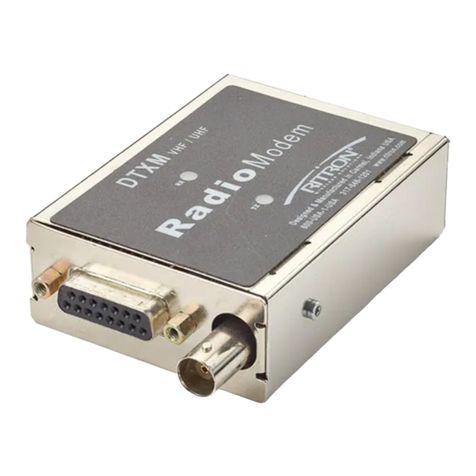
Ritron
Ritron DTXM-460-0BN6I-M-FIPS User manual
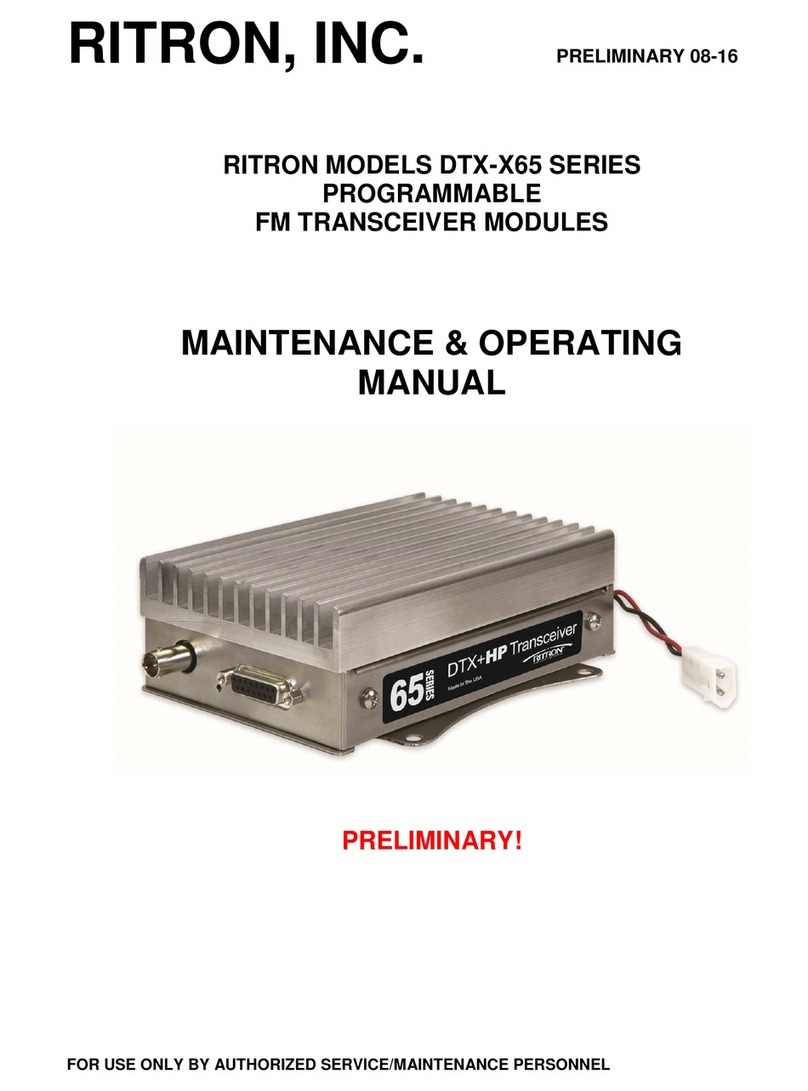
Ritron
Ritron DTX-165-0 Operating and maintenance manual
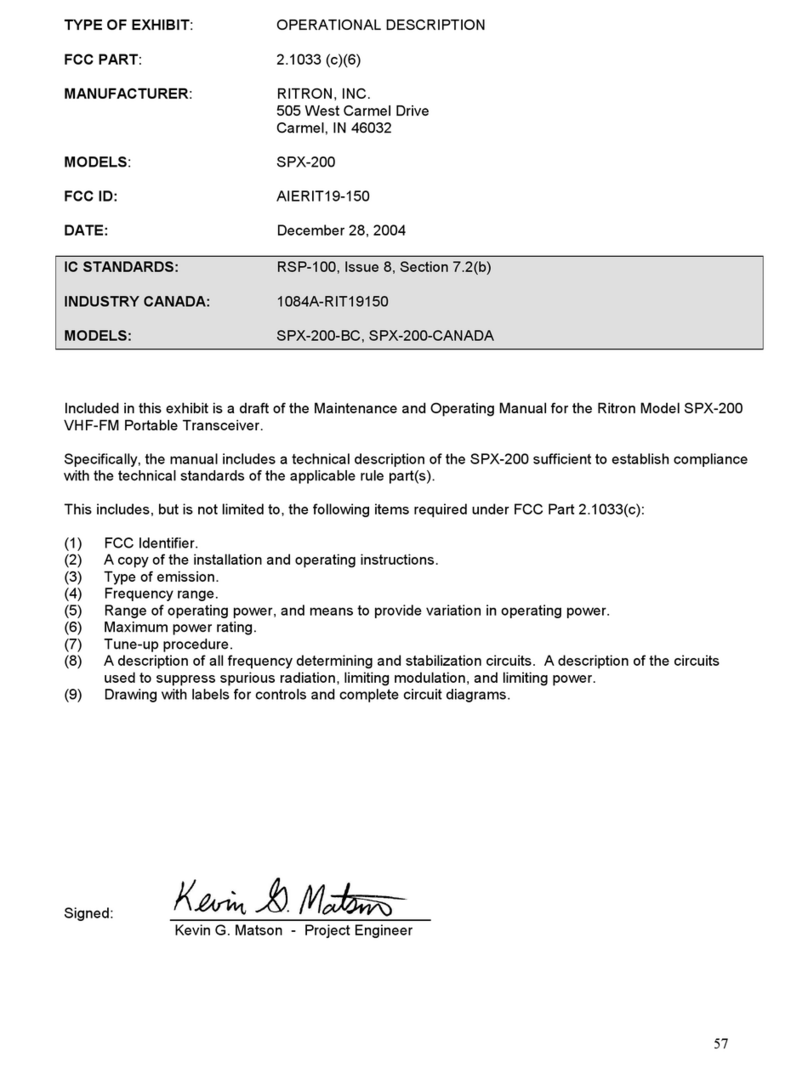
Ritron
Ritron SPX-200 User manual
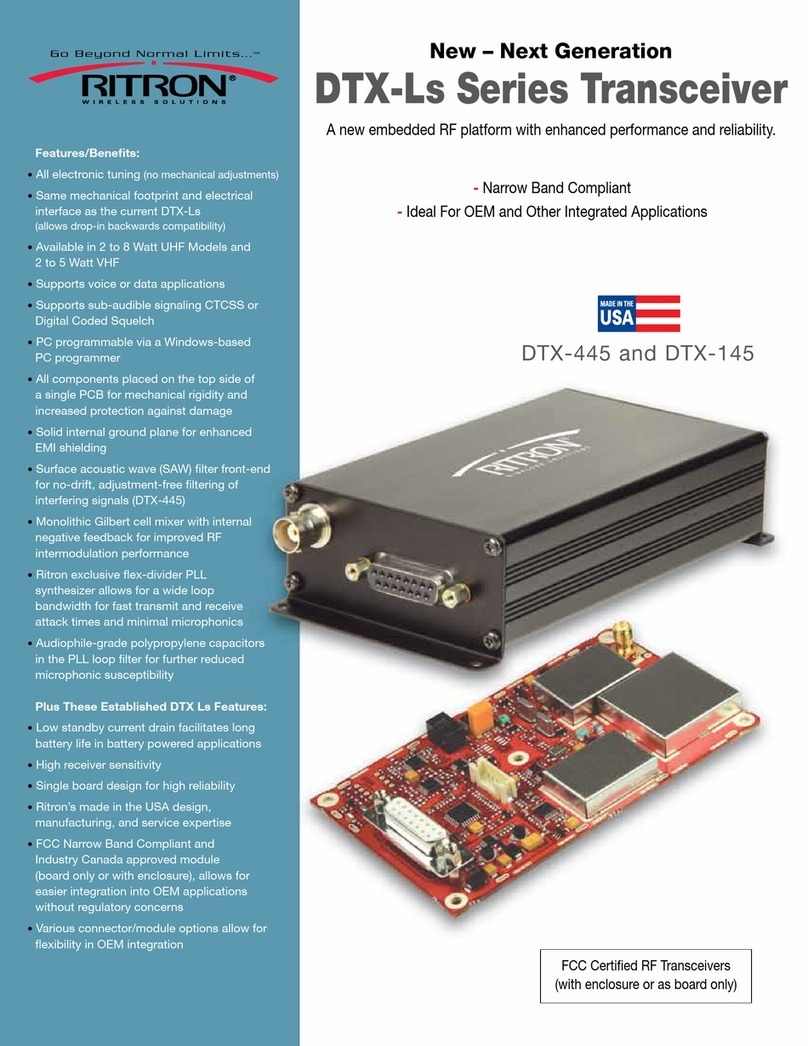
Ritron
Ritron DTX-Ls Series User manual

Ritron
Ritron RPM-050 User manual

Ritron
Ritron RPM-150 Installation and operating instructions

Ritron
Ritron RT-453 Operating and maintenance manual
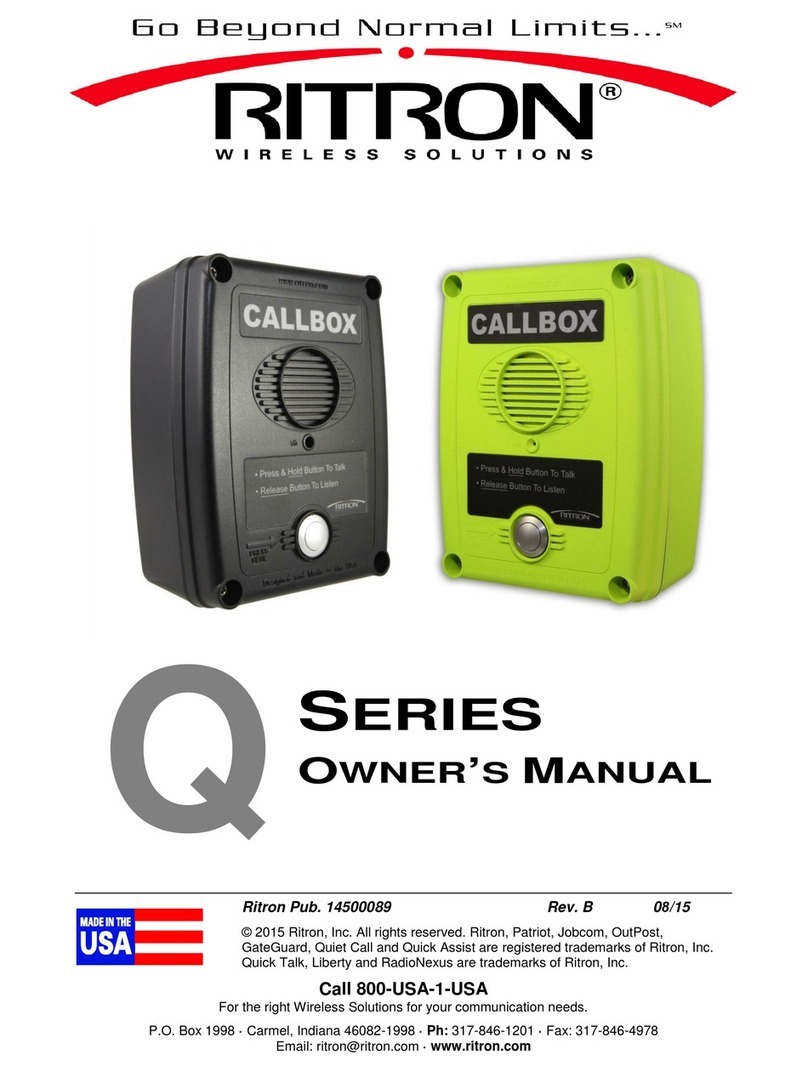
Ritron
Ritron Q Series User manual

Ritron
Ritron RPM-150 User manual


